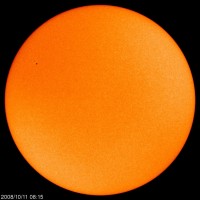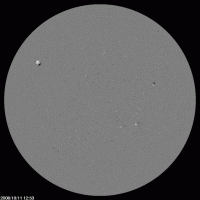
|
Oct 15, 2008
Cold Pacific Brings Dramatic Cooling to Northwestern North America
By Craig Medred, Anchorage Daily News
Two hundred years of glacial shrinkage in Alaska, and then came the winter and summer of 2007-2008. Unusually large amounts of winter snow were followed by unusually chill temperatures in June, July and August. “In mid-June, I was surprised to see snow still at sea level in Prince William Sound,” said U.S. Geological Survey glaciologist Bruce Molnia. “On the Juneau Icefield, there was still 20 feet of new snow on the surface of the Taku Glacier in late July. At Bering Glacier, a landslide I am studying, located at about 1,500 feet elevation, did not become snow free until early August.
“In general, the weather this summer was the worst I have seen in at least 20 years.” Never before in the history of a research project dating back to 1946 had the Juneau Icefield witnessed the kind of snow buildup that came this year. It was similar on a lot of other glaciers too. “It’s been a long time on most glaciers where they’ve actually had positive mass balance,” Molnia said. That’s the way a scientist says the glaciers got thicker in the middle.

Cold temperatures set several new record lows this weekend, including a low of 22 Saturday in downtown Pendleton, Oregon that broke a 118 year-old record of 24. Record lows started falling Thursday with a new low of 20 for Meacham, four degrees cooler than the previous record from 2006, according to information from the Web site for the National Weather Service Forecast Office in Pendleton.
In northern California, a record cold snap in Mendocino County over the weekend caused little damage to wine grapes but chilled the hearts of farmers who already have suffered huge losses this year. “It’s just one more thing on top of one more thing. You kind of hold your breath,” said Potter Valley wine grape grower Bill Pauli. Temperatures dropped to 31 degrees in the Ukiah Valley on Saturday night and early Sunday morning, the coldest Oct. 12 morning since record keeping began in Ukiah in 1893, said Troy Nicolini, a meteorologist with the National Weather Service in Eureka. The previous record was 34 degrees in 1916.
Farmers in Redwood Valley and other cooler regions in Mendocino County reported temperatures as low as 27 degrees. An estimated 30 percent to 50 percent of that county’s wine grape crop had yet to be harvested when the frost hit, killing the tops of unprotected vines and effectively freezing the ripening process.
Oct 14, 2008
West Antarctic Ice Sheet
By CO2 Science on SPPI
Is the West Antarctic Ice Sheet (WAIS) growing or shrinking? Climate alarmists would have everyone believe that it is rapidly disappearing; while the illuminati—Al Gore and James Hansen—prophetically proclaim that we have but a few short years in which to (1) repent of our profligate usage of fossil fuels, (2) preserve the ice at the planet’s southern pole by curbing our appetite for fossil-fuel energy and stopping global warming, and (3) avoid the catastrophic rise in sea level that would otherwise inundate the world’s coastal lowlands. But are these zealots correct in what they preach? In what follows, we briefly review the findings of several researchers who have focused their attention on the mass balance of the WAIS in an attempt to help reason prevail over rhetoric in this important but contentious war of words.

We conclude our Summary with a brief review of the paper of Krinner et al. (2007), who used the LMDZ4 atmospheric general circulation model (Hourdin et al., 2006) to simulate Antarctic climate for the periods 1981-2000 (to test the model’s ability to adequately simulate present conditions) and 2081-2100 (to see what the future might hold for the mass balance of the Antarctic Ice Sheet and its impact on global sea level). This work revealed, first of all, that “the simulated present-day surface mass balance is skilful on continental scales,” which gave them confidence that their results for the end of the 21st century would be reasonably skilful as well. Of that latter period a full century from now, they determined that “the simulated Antarctic surface mass balance increases by 32 mm water equivalent per year,” which corresponds “to a sea level decrease of 1.2 mm per year by the end of the twenty-first century,” which would in turn “lead to a cumulated sea level decrease of about 6 cm.” This result, in their words, occurs because the simulated temperature increase “leads to an increased moisture transport towards the interior of the continent because of the higher moisture holding capacity of warmer air,” where the extra moisture falls as precipitation, causing the continent’s ice sheet to grow.
The results of this study—based on sea surface boundary conditions taken from IPCC Fourth Assessment Report simulations (Dufresne et al., 2005) that were carried out with the IPSL-CM4 coupled atmosphere-ocean general circulation model (Marti et al., 2005), of which the LMDZ4 model is the atmospheric component—argue strongly against climate-alarmist predictions of future catastrophic sea level rise due to mass wastage of the Antarctic Ice Sheet caused by CO2-induced global warming. In fact, they suggest just the opposite, i.e., that CO2-induced global warming would tend to buffer the world against such an outcome.
And that seems to be the message of most of the other major studies of the subject as well. We have nothing to fear but fear itself ... plus Al Gore and James Hansen, who seem to be its chief purveyors. Read the very detailed CO2 Science survey here. See story on how Winds are the Dominant Cause of Greenland and Antarctic Ice Sheet Losses here.
Oct 12, 2008
The Climate Change Unbelievers
By Tim Walker, UK Independent
Global warming is happening and we’re to blame, right? That’s certainly the view of almost every expert in the field. But a die-hard band of naysayers continues to rail against the consensus. Are they completely mad? Judge for yourself.
Not everybody likes Gore and his beliefs about the future of our planet and especially not Hans Schreuder, the 62-year-old former chemist who runs the Gore-baiting website Ilovemycarbondioxide.com. Schreuder is one of the climate-change sceptics who continue to make their case despite the mounting evidence of climate change that we, the public, are presented with every day; despite the unanimous endorsement of climate-change theory by every national academy of science in the industrialised world.
The sceptics declare that the central evidence for carbon-driven climate change in the reports of the IPCC are nonsense. Specifically, the “hockey stick” graph, which correlates the steep rise in world temperatures to the steep rise in carbon emissions, and which Gore demonstrates, with the help of a hydraulic crane, in his film An Inconvenient Truth. Gore’s opponents say there’s evidence that world temperatures have, in fact, begun to fall since 2000.
In 2005, the House of Lords Economics Committee voiced “concerns” about the objectivity of the IPCC, suggesting some of the agency’s emissions projections were “influenced by political considerations”. The committee’s claims were subsequently rejected by the Government and the Stern Review on the economics of climate change, but the vested-interests argument unites sceptics, and mirrors the accusations often levelled at them in turn, that they are in the pockets of big oil, big gas, or the US Republican Party.
The sceptics come from the worlds of politics, economics, television and, crucially, science. David Bellamy, a professor of botany who was formerly the televisual face of eco-evangelism, has been compared with a Holocaust denier because he doesn’t believe carbon emissions cause climate change. Climatologist Piers Corbyn is convinced climate change is caused by solar activity, not CO2. Economist Ruth Lea warns of the IPCC’s political and business interests. Martin Durkin, maker of the documentary The Great Global Warming Swindle, says the green industry is in too deep to afford to acknowledge scientific law. And the former Chancellor, Nigel Lawson, maintains that though the science of climate change could be broadly correct, its consequences have been exaggerated. Read more here.
This story implies the skeptic voices are few and far between. See how EPW has over listed 500 scientists who have taken positions against the so called consensus here, see the Petition Project with over 31,000 signatures and 9,100 PhD.s arguing there is no convincing scientific evidence that man is causing catastrophic effects on the earth’s climate here, and the Manhattan Declaration from the first International Climate Change Conference stating “Global warming” is not a global crisis here.
Oct 12, 2008
Significant Cycle 24 Sunspot Group Emerges
By Anthony Watts, Watts Up With That
This is the biggest Cycle 24 spot since the first one was seen on January 4th, 2008. This spot looks to have some staying power other than the “specks” we’ve seen winking on and off lately. No squinting to see this one, or wondering if it’s a dead pixel in the SOHO CCD imager or not.

See larger image here
The corresponding magnetogram image, seen here, is also quite pronounced.

The polarity is correct, with the white “North” at the top. This spot grew quickly as it came around the rim into visibility. Watch this animation here.
At the same time, to the right of the image, at lower latitude, a new cycle 23 sunspot seems to be emerging, note it has a reveresed polarity from the larger SC24 spot. Solar cycle 23 just won’t give up it seems.
The magentic field, as shown by the Average Planetary index (Ap) remained low in September, see here.
Oct 11, 2008
Record Early Snow Hitting Northern Rockies
By Zack Benoit, Billings Gazette
An early-winter storm kicked into high gear Friday, blanketing much of southern Montana and northern Wyoming with snow. Wet, heavy snow fell throughout the day in Billings. The storm is expected to continue at least through Sunday and bring as much as 20 inches of snow to the Billings area. A snowfall record for Oct. 11 was set in Billings yesterday. According the National Weather Service, Billings saw 3.1 inches of snow Friday. The old record of 2.8 inches was set in 1969. See video story here.
By 9 a.m. today, many towns in the region were reporting heavy snowfall. Park City and Colstrip each received 5 inches, Red Lodge reported 18 inches and Nye had 19. As of 3pm MDT Saturday, Cole Creek reported 34 inches. Areas in Eastern Montana have not received much snow, but it has been raining - Miles City reported about 0.5 inches this morning - but snow is expected to begin falling there this evening. Read more here.
Meanwhile to the west in Idaho according to the Idaho Stateman story, Boise had the earliest snow on record. Big snow flakes fell early Friday evening, turning Downtown Boise into a giant snow bowl for people on their way home from work. The snow caught many people off guard, including this bicyclist heading down Idaho Street between 8th and 9th around 5:45 p.m.

Across the Treasure Valley, tree branches heavy with wet, snow-covered leaves fell on power lines, causing scattered power outages.
This is the earliest measurable snowfall in Boise since record keeping began in 1898, according to the National Weather Service. At 10 p.m., the Weather Service said 1.7 inches of snow had fallen. The previous earliest recorded snowfall was Oct. 12, 1969, when a little more than an inch fell. And if the snow wasn’t enough, meteorologists say winds across southwestern Idaho will average 25 to 40 mph through Saturday afternoon, with gusts up to 55 mph. Sustained winds of 30 to 40 mph are expected, which can make driving difficult.
|
|
|
|







